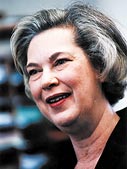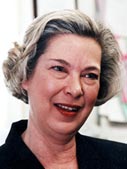 |
 |
|||||
 |
 |
 |
 |
 |
||||||||||||
 |
 |
 |
||||||||||
| Mercy Sister Marion Cypser: “In terms of caring, the parents care more than ever, and are very articulate about what they want.” Catholic New World photos / David V. Kamba
Veteran leader brings sense of stability to school
Mercy Sister Marion Cypser has served as principal of St. Catherine of Siena-St. Lucy for 24 years— the bulk of her 34-year career in education. The 310-student school serves a parish that sits on the boundary of Oak Park and Chicago, with a predominantly African-American, non-Catholic student body. Cypser taught for only five years before taking her first position as a principal. This year, she was honored by the National Catholic Education Association as the Distinguished Principal of the Year for the Great Lakes Region. The Catholic New World: How did you end up as a principal so early in your career? Sister Marion Cypser: I was teaching primary grades at St. Raymond (de Penafort) in Mount Prospect. The principal had resigned at Little Flower School, and it was a bad situation. The school was at 80th and Paulina, and that part of the city was going through redlining at the time, and they lost the entire school enrollment. During the summer, the neighborhood changed from white to black overnight. It was probably one of the most extreme cases of white flight in the city. At that time, our community asked if two of us would go—they didn’t want to send one person. So I went as a co-principal with another Sister of Mercy. During the summer, we got the enrollment from zero to 600. We opened up with 600. I got there, I suppose, because I had a lot of energy and I was a very successful teacher at that point. I was 27 years old. TCNW: What are you most proud of at St. Catherine-St. Lucy? SMC: I think our stability. Being here 24 years, I think what I probably do is bring a sense of stability. We have had a stable enrollment for 23 years. We seek very little outside funding. We’re not on grant. Tuition and parent fund-raising pay our bills. It’s becoming much more difficult now, and I’m beginning to get some Big Shoulders scholarships—we are a Big Shoulders school because of our poverty level. According to our free and reduced price school lunches, we’re at the 76 percent poverty level, so it’s fairly high. Because we’ve been able to raise some money in the past, we have not received any grants, but I think that’s going to change. It’s becoming more and more difficult for the parents to pay the tuition that’s needed to run the school. ... Many of our families now were children in the school. About 50 of my parents went to school here, so I was their principal, and now I’m their children’s principal. That’s fun, because the parents will say to me, “Wow, this hasn’t changed,” or “This has changed, this is great.” All the rules, et cetera—they’ll say, “I remember the rules.” That helps in terms of stability and the sense of community. TCNW: Has the school always been mostly African-American? SMC: At the beginning, we were about 30 percent white. St. Catherine’s merged with St. Lucy’s in 1973. St. Catherine’s was predominantly white; St. Lucy’s was predominantly black. It was a very rocky, rough time. When I arrived in 1978, the white children were mainly in the upper grades, and they stayed here until they graduated. We mainly attracted the black families that were part of St. Lucy’s Parish, or within its boundaries. Through the years, we have had a few white families come to the school that are parishioners that really wanted to send their children here, and it’s been fine. It’s been difficult attracting white families to the school. They perceive it as an all-black school, and it’s been difficult to turn that around. I think it would be more real to have an integrated situation but it’s not that way. TCNW: How do your students do academically? SMC: Very well. We are unique in the fact that over 90 percent of our students in the eighth grade go on to Catholic high schools, and 90 percent of them are non-Catholic. What that says to me is that their parents value an excellent education, and their perception is that the Catholic schools do it very well. TCNW: How have things changed in Catholic education in the last 24 years? SMC: I think on the down side, there is not as much parental involvement, because with the societal changes and both parents needing to work, they’re not as involved. In terms of caring, the parents care more than ever, and are very articulate about what they want. They’re also very knowledgeable about education. In terms of curriculum, it’s much more hands-on, cooperative learning, children being involved in their learning rather than listening to a lecture. We’ve tried to make those changes throughout the school. We had a large donation from a former student, so we were able to buy a lot of science equipment this year. So in seventh grade, they’re actually doing sophomore biology—they’re dissecting frogs and worms and putting them under the microscopes. That was not true 20 years ago. Then, it was more straight lecture and discipline. TCNW: With such a high percentage on non-Catholic students, how do you keep your identity as a Catholic school? SMC: Our teachers are all Catholic, and we teach from Catholic religion books. The fact that our children are not Catholic—we use the opportunity for evangelization. Children go to Mass every week as a class. They help with the readings, they’re involved with the liturgy. We have special liturgies eight times a year where the whole school goes, and parents come. We do have a few families each year who enroll in the RCIA (Rite of Christian Initiation for Adults) program to become Catholic members of the parish. I also make sure it looks like a Catholic school, in terms of crosses and pictures. If you walk down the halls, you’ll see a lot of religion stuff. During Lent, the children made their own Stations of the Cross. If you walk in the classrooms, you’ll know by the way the teachers are teaching that it’s a Catholic school. TCNW: What are your goals? SMC: I see myself staying where I am. My passion is for education. I feel very strongly that it is one way out of the poverty cycle: to have the children educated, to have the parents educated, to have the parents interested in their children’s learning. I see myself staying in education, whether it be as an administrator or a teacher. I have no aspirations to do anything else.
Front Page | Digest | Cardinal | Interview |
||||||||||||